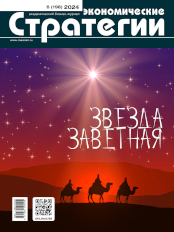Results of Russia’s Strategic Development for the First Three Quarters of 2024: Structural Transformation of the Economy Continues
DOI: 10.33917/es-6.198.2024.84-89
The article dwells on the change in the market index of the “Economic Strategies” (MIES) for the first nine months of 2024.
Contribution of supply and demand indicators to the MIES is assessed. Industrial production is analyzed.
References:
1. Informatsiya o XIII s”ezde Federatsii nezavisimykh profsoyuzov Rossii ot 29 oktyabrya 2024 g. [Information about the XIII Congress of the Federation of Independent Trade Unions of Russia dated October 29, 2024]. Ofitsial’nyy sayt Prezidenta RF, available at: http://kremlin.ru/events/president/news/75434
2. Sotsial’no-ekonomicheskoe polozhenie Rossii v yanvare — sentyabre 2024 goda [Socio-economic Situation in Russia in January — September 2024]. Federal’naya sluzhba gosudarstvennoy statistiki, available at: https://rosstat.gov.ru/storage/mediabank/osn-09-2024.pdf
3. Informatsiya o strategicheskoy sessii Pravitel’stva Rossiyskoy Federatsii o formirovanii edinogo plana po dostizheniyu natsional’nykh tseley razvitiya na period do 2030 goda i na perspektivu do 2036 goda ot 12 noyabrya 2024 g. [Information on the Strategic Session of the Government of the Russian Federation on the Formation of a Unified Plan for Achieving National Development Goals for the Period up to 2030 and for the Future up to 2036 dated November 12, 2024]. Ofitsial’nyy sayt Pravitelstva RF, available at: http://government.ru/news/53282/
4. Prognoz sotsial’no-ekonomicheskogo razvitiya Rossiyskoy Federatsii na 2025 god i na planovyy period 2026 i 2027 godov [Forecast of Socio-economic Development of the Russian Federation for 2025 and for the Planning Period of 2026 and 2027], available at: file:///C:/Users/%D0%BF%D0%BA/Desktop/prognoz_socialno_ekonomicheskogo_razvitiya_rf_2025-2027.pdf
5. Frenkel’ A.A., Tikhomirov B.I., Surkov A.A. Sotsial’no-ekonomicheskoe razvitie Rossii v I kvartale 2024 g. — ekonomicheskiy rost uskoryaetsya [Socioeconomic Development of Russia in the First Quarter of 2024 — Economic Growth is Accelerating]. Ekonomicheskie strategii, 2024, no 3(195), pp. 120–125, DOI: https://doi.org/10.33917/es-2.195.2024.120-125
6. Ukaz Prezidenta RF ot 7 maya 2024 g. “O natsional’nykh tselyakh razvitiya Rossiyskoy Federatsii na period do 2030 goda i na perspektivu do 2036 goda” [Decree of the President of the Russian Federation of May 7, 2024 “On the national development goals of the Russian Federation for the period up to 2030 and for the perspective up to 2036”]. Ofitsial’nyy sayt Prezidenta RF, available at: http://kremlin.ru/events/president/news/73986












